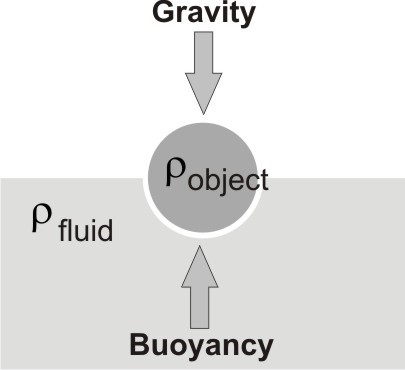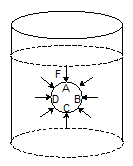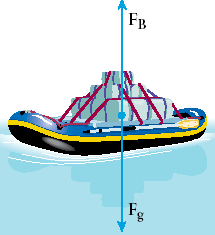Buoyant Force
When an object is immersed in a liquid, it experiences an upward force due to the liquid because of which it feels lighter. This upward force is called ‘Buoyant force’. Buoyant force is also known as upthrust.

- When a piece of wood is held below the surface of water and then released, the wood immediately rises to the surface. It means some upward force is exerted by water on the wood which pushes it to the surface.
- When a stone lying at the bottom of a pond is lifted up, it appears to be light as long as it is being lifted inside water. But as soon as the stone is lifted out of water into air, one feels it to be much heavier. It means some upward force acts on the stone when it is immersed in water and makes us feel lighter.
Also Check: Force
Cause of Buoyant Force
Consider a rubber ball dipped completely inside a liquid filled in a beaker. The liquid in contact with the ball exerts a force in perpendicular direction, pressing it. Therefore, the force on the surface near the topmost point A is downwards, whereas on the surface near the lowest point, C it is upwards. The force on the surface near the point B is towards the left and near the point D is towards the right. Now, the forces acting on it are not equal in magnitude.
The point C lies at a greater depth than point A. Therefore pressure at C is larger than A. Consider equal areas near A and C.

It means upwards force near C is larger in magnitude than the downward force near A. Therefore, the forces exerted on different parts of the ball by the liquid are not balanced. Hence the resultant force exerted by the liquid acts in upward direction, which is called buoyant force.
Factors Affecting Buoyant Force
The magnitude of buoyant force acting on an object immersed in a liquid depends on two factors:
- Volume of the Solid object immersed in the liquid : As the volume of object immersed inside the liquid increases, the upward buoyant force increases. When the object is completely immersed in the liquid, the buoyant force is at its maximum.
- Density of the liquid in which the object is immersed: As the density of liquid increases, the buoyant force exerted by the liquid also increases, e.g. sea-water has higher density than fresh water, and therefore sea-water will exert more buoyant force on an object immersed in it than the fresh water.

Also Check: Frictional Force
BUOYANT FORCE HELPING A BOAT TO FLOAT OVER WATER
Archimedes Principle
When a solid body is fully or partially immersed in a fluid, the fluid exerts an upward force on the body, and this force has a magnitude equal to the weight of displaced fluid. In other words,

Buoyant force acting on an object = weight of the displaced fluid
The force exerted by a fluid on a solid body dipped partially or fully in it is called the buoyant force, e.g. if only a part of the ball is inside the liquid, then it displaces a smaller volume of liquid. The volume of the liquid displaced is equal to the volume of that part of the ball which is inside the liquid. The net force exerted on the ball by the liquid is again in the upward direction and it is equal to the weight of the displaced liquid.
This rule is also applicable for solids immersed in gases.
A body of weight W is completely immersed in a liquid and released, and then the two forces acting on it are:
- The weight W, of the body in downward direction.
- Buoyant force B exerted by the liquid in upward direction.
Therefore,
- If W > B, then net force on the body is in downward direction and the body sinks. It reaches the bottom and stays there.
- Principle of Floatation: If B > W, net force on the body will be in upward direction. Body will come to the surface and floats, with a part of it inside the liquid. A body will float in a liquid if the weight of the liquid displaced by it, is greater than equal to its own weight. This is called the principle of floatation.
- For a floating body, to be in equilibrium,
Weight of the liquid displaced = Weight of the body or B = W
Ques: If a body of density 5 x 103 kg/m3 and volume 4m3 immersed in a fluid of density 4 x 103 kg/m3, find the buoyant force acting on the body. (g = 10 m/s2 )
Solution: Volume of body = 4 m3
Water displaced by the body = volume of the body = 4m3
Mass of the liquid displaced = Water displaced density of liquid
= 4m3 x 4 x 103 kg/m3 = 16 x 103 kg
Weight of liquid displaced = 16 x 103 kg x g
= 16 x 103 x 10 N
= 16 x 104 N
Also Check: Thrust & Pressure
DENSITY, APPARENT WEIGHT AND RELATIVE DENSITY
Density of a Substance
Density of a substance is defined as its mass per unit volume. Its SI unit is Kg/m3. Under specified conditions, it is always same. Therefore, it is one of the characteristic properties of the substance.

Apparent Weight
When a body is dipped in a liquid, the liquid exerts an upward force on it which is called buoyant force. Due to which less force is needed to hold the body. This, weight of the body inside a liquid is called the apparent weight of the body. Apparent weight of a body dipped in a liquid is less than its true weight.
Relative Density
The relative density of a substance is the ratio of its density to that of water. That is:
Relative density of a substance = Density of the substance / Density of Water
We know that, Density = Mass / Volume, so by writing Mass / Volume in place of the density in the above relation, we get:
Relative density of a substance = Mass of the Substance / Volume of the Substance x Volume of Water / Mass of Water
Now, if we take ‘equal volume of the substance and of water’, then the two volume factors of the above relation cancel out, and we are left with:
Relative density of a substance = Mass of the Substance / Mass of equal volume of Water
This relation gives us the following definition of relative density. The relative density of a substance is the ratio of the mass of any volume of the substance to the mass of an equal volume of water. In other words, the relative density of a substance is the mass of the substance relative to the mass of an equal volume of water. As the relative density is a ratio of two similar quantities (masses), it has no units.
The relative density of a substance expresses the heaviness (or density) of the substance in comparison to water. For example, the relative density of iron is 7.8. Now, by saying that the relative density of iron is 7.8 we mean that iron is 7.8 times as heavy as an equal volume of water. (Relative density is also known as specific gravity)
Frequently Asked Questions on Buoyant Force
Buoyancy is important in swimming because it helps you stay up in the water. When you're underwater, the pressure pushing on you is higher than the pressure above the water. This difference in pressure helps you float on the surface.
Buoyancy is caused by the pressure of the fluid pushing against an object immersed in it. The buoyant force always pushes upwards because the pressure of the fluid increases as you go deeper.
There are three types of buoyancy: positive, negative, and neutral.
- Positive buoyancy is when an object is lighter than the fluid it displaces, causing it to float.
- Negative buoyancy occurs when an object is denser than the fluid, causing it to sink.
- Neutral buoyancy happens when an object's weight equals the fluid it displaces, like when a scuba diver is in balance underwater.
Examples of buoyancy include boats and ships floating on water, and cork floating in water.
Buoyancy is directly related to the density of the fluid. The denser the fluid, the greater the buoyant force pushing upwards.